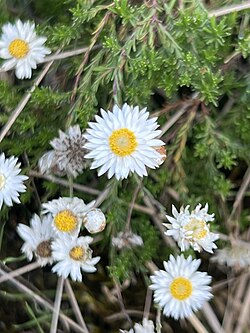Biology:Helichrysum calvertianum
| Helichrysum calvertianum | |
|---|---|

| |
| Scientific classification | |
| Kingdom: | Plantae |
| Clade: | Tracheophytes |
| Clade: | Angiosperms |
| Clade: | Eudicots |
| Clade: | Asterids |
| Order: | Asterales |
| Family: | Asteraceae |
| Genus: | Helichrysum |
| Species: | H. calvertianum
|
| Binomial name | |
| Helichrysum calvertianum | |
Helichrysum calvertianum is a species of flowering plant in the family Asteraceae. It is a small subshrub with small crowded leaves and single white daisy-like flowers. It is endemic to the Southern Highlands in New South Wales.
Description
Helichrysum calvertianum is a small, many branched subshrub to 30 cm (12 in) high with smooth stems and occasional woolly, small glandular hairs. The green crowded leaves are sticky, linear, 3–8 mm (0.12–0.31 in) long, 0.5–0.8 mm (0.020–0.031 in) wide, margins rolled under concealing the lower surface. The papery white, daisy-like flowers are borne singly at the end of wiry branches, 0.7–1 cm (0.28–0.39 in) long and 1–1.5 cm (0.39–0.59 in) in diameter with yellow centres. The bracts are scaly, brownish, somewhat hairy near the base, intermediate bracts longer with pale, papery edges, sometimes tinted pink near the apex, outer bracts golden and translucent, innermost bracts narrow with small, papery white edges. Flowering occurs from January to August and the fruit are a dry, one-seeded, slightly glandular, oblong to needle-shaped, bristly and almost feathery at the tip.[2][3][4]
Taxonomy and naming
Helichrysum calvertianum was first formally described 1877 by Ferdinand von Mueller as Helipterum calvertianum and the description was published in Fragmenta Phytographiae Australiae.[5][6] In 1882 Mueller changed the name to Helichrysum calvertianum.[7][8] The specific epithet (calvertianum) is in honour of "Mrs Calvert" (nee Louisa Atkinson), a plant collector for Mueller.[9]
Distribution and habitat
This species grows mostly on Hawkesbury sandstone in heavier, moist soils, on or near rock platforms and in dry sclerophyll forest. It is restricted to the Southern Highlands between Joadja, Belanglo, Fitzroy Falls and Mount Gibraltar.[2][4]
Conservation status
Helichrysum calvertianum is classified as a "vulnerable species" in New South Wales.[10]
References
- ↑ "Helichrysum calvertianum". Australian Plant Census. https://biodiversity.org.au/nsl/services/apc-format/display/59296.
- ↑ Jump up to: 2.0 2.1 Everett, J. "Helichrysum calvertianum". Royal Botanic Gardens Sydney. https://plantnet.rbgsyd.nsw.gov.au/cgi-bin/NSWfl.pl?page=nswfl&lvl=sp&name=Helichrysum~calvertianum.
- ↑ Fairley, Alan (2004). Seldom Seen-Rare Plants of Greater Sydney. Reed New Holland. p. 110. ISBN 1876334991.
- ↑ Jump up to: 4.0 4.1 Fairley, Alan; Moore, Philip (2010). Native Plants of the Sydney Region (3rd ed.). Crows Nest: Jacana Books. p. 454. ISBN 9781741755718.
- ↑ von Mueller, Ferdinand (1877). Fragmenta Phytographiae Australiae 10(87) (10 ed.). Melbourne. p. 108. https://www.biodiversitylibrary.org/item/252055#page/118/mode/1up.
- ↑ "Helipterum calvertianum". Australian Plant Name Index. https://biodiversity.org.au/nsl/services/rest/instance/apni/476518.
- ↑ "Helichrysum calvertianum". Australian Plant Name Index. https://biodiversity.org.au/nsl/services/rest/instance/apni/463605.
- ↑ von Mueller, Ferdinand (1882). Systematic Census of Australian Plants. Melbourne. p. 81. https://www.biodiversitylibrary.org/item/114607#page/93/mode/1up.
- ↑ "Louisa Atkinson". Council of Heads of Australasian Herbaria. http://www.anbg.gov.au/biography/atkinson-louisa.html.
- ↑ "Helichrysum calvertianum". NSW Department of Planning, Industry and Environment. https://www.environment.nsw.gov.au/topics/animals-and-plants/threatened-species/nsw-threatened-species-scientific-committee/determinations/final-determinations/2019/helichrysum-calvertianum-vulnerable-species-listing.
Wikidata ☰ Q15579865 entry
 |

